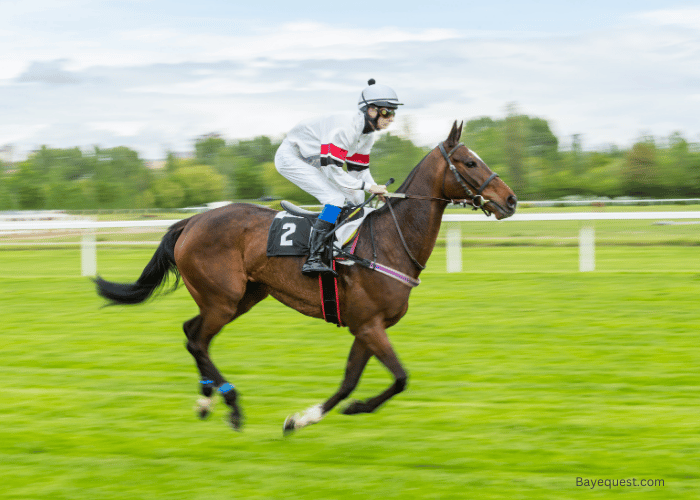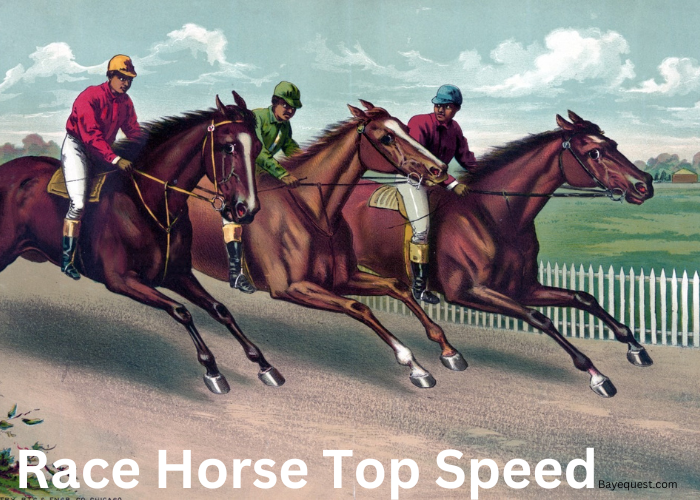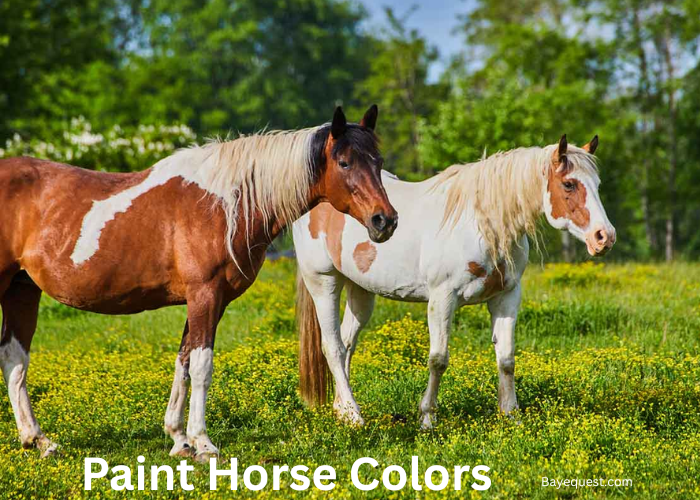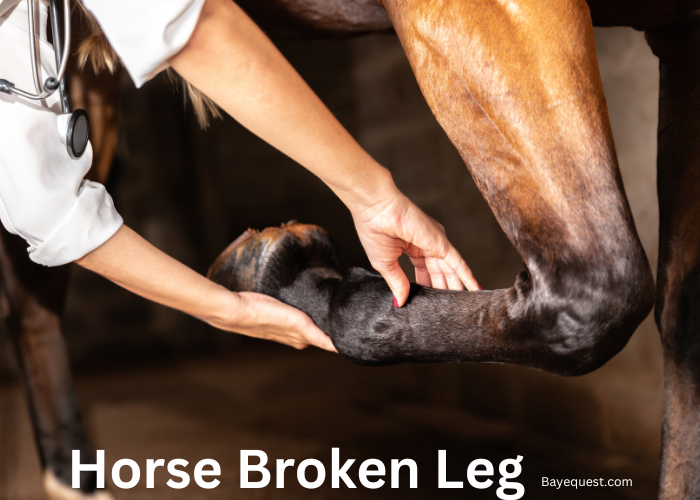The sound of hooves pounding the track is pure magic. It’s power, speed, and adrenaline in perfect harmony.
Racehorses are built for one purpose: to be fast. But how fast can they really go?
In the world of racing, speed isn’t just a number. It’s what separates champions from the rest.
Let’s dive into the thrilling world of race horse top speeds. Discover what makes these animals some of nature’s most incredible athletes.
Race Horse Top Speed: Key Takeaway
Thoroughbred racehorses are among the fastest in the world. They are capable of reaching speeds up to 44 miles per hour (71 km/h) over short distances. On average, they maintain a speed of 38 miles per hour (61 km/h) across typical race distances. These impressive speeds make Thoroughbreds the stars of horse racing.
How Fast Do Race Horses Run?
Racehorses can reach impressive speeds, with the fastest Thoroughbreds clocking in at around 40 to 44 mph (64 to 71 kph) during a race.
The Quarter Horse, known for its explosive sprinting ability, can hit speeds of up to 55 mph (88 kph) over short distances.
These speeds make racehorses some of the fastest land animals. They rival the quick bursts of speed seen in animals like the cheetah, though over shorter distances.
What is the Average Speed of a Horse?
The average speed of a horse varies depending on the breed and activity.
Most horses trot at about 8 to 12 miles per hour (13 to 19 kilometers per hour). When galloping, they usually reach speeds of 25 to 30 miles per hour (40 to 48 kilometers per hour).
However, racehorses are much faster, averaging around 35 to 40 miles per hour (56 to 64 kilometers per hour) during races.
Factors Affecting a Racehorse’s Speed
Stride
A horse’s stride is the distance it covers in a single leap. The longer the stride, the fewer steps the horse needs to take to cover the same distance, which can translate into higher speeds.
Horses with a smooth, extended stride are often faster because they conserve energy while maintaining momentum. The frequency of their strides, known as stride rate, also plays a role.
A horse with both a long stride and a high stride rate can achieve remarkable speeds. It’s not just about how far they reach, but how efficiently they do it.
Genetics and breeding
Genetics and breeding are fundamental to a racehorse’s speed. Horses inherit traits from their parents.
Top breeders carefully select horses with proven speed, stamina, and physical attributes.
The right combination of genes can result in a horse with a powerful heart, strong muscles, and an optimal body structure for racing.
Speedy ancestors often pass on traits like lung capacity, muscle fiber composition, and overall athleticism.
Breeding isn’t just about pairing two fast horses. It’s about understanding the bloodlines and ensuring the best traits are passed down.
Track conditions
Track conditions can significantly influence a racehorse’s speed. A dry, firm track allows for faster times as horses can get better traction and maintain a steady pace.
On the other hand, a wet or muddy track can slow a horse down, making it harder to gain speed and increasing the risk of slipping.
Even the track’s material, whether dirt, turf, or synthetic, can affect performance.
Horses trained on a particular surface type might struggle to maintain speed when racing on unfamiliar terrain. The track’s condition can make or break a race.
Jockey influence
A jockey’s influence on a racehorse’s speed is critical.
An experienced jockey knows how to pace the horse, saving energy for the final sprint. They understand the horse’s strengths and weaknesses and can adjust their strategy mid-race.
The way a jockey positions the horse during the race, either leading or following, can impact the horse’s speed.
A well-timed encouragement can push a horse to its top speed, whether through reins or voice.
The connection between jockey and horse is vital; trust and understanding can lead to winning speeds.
Related read: How Much Do Jockeys Make?
Diet
A racehorse’s diet directly affects its speed. A balanced diet provides the necessary energy for high-performance racing.
Horses require a mix of carbohydrates for quick energy, proteins for muscle repair and growth, and fats for sustained energy.
Vitamins and minerals are also crucial to maintaining overall health and performance.
Overfeeding or underfeeding can lead to weight issues, which can slow a horse down. Hydration is equally important; a well-hydrated horse can maintain peak performance.
A tailored diet helps a horse achieve the energy levels needed to reach and sustain top speeds.
Training
Training is the backbone of a racehorse’s speed. It involves building stamina, strength, and agility through a structured regimen.
Regular exercise improves cardiovascular health, enabling the horse to run longer and faster. Speed work, where horses practice sprints, enhances their ability to accelerate quickly.
Training also involves conditioning the horse’s muscles, improving their power and efficiency. Mental training is just as important; a focused and calm horse can perform better under race conditions.
Consistent, well-rounded training prepares a horse to perform at its best, maximizing its speed potential.
How Does Anatomy Affect Horse Speed?
A horse’s anatomy plays a crucial role in its speed.
Long legs allow for extended strides, covering more ground with each step. Strong muscles, especially in the hindquarters, provide the power needed for quick acceleration.
A large heart and lungs improve oxygen delivery, enabling the horse to sustain high speeds.
The shape of the horse’s body, known as conformation, affects how efficiently it moves.
Horses with a well-balanced, aerodynamic body can cut through the air with less resistance.
Additionally, flexible joints allow for smoother, faster movement, reducing the risk of injury during races.
Interesting read: How to Read a Racing Form for Horses.
How to Improve Your Horse’s Speed
Improving your horse’s travel speed requires a balanced approach.
Start with a consistent training routine that includes regular sprint exercises to build speed. Focus on improving stride length and stride rate through specialized drills.
Ensure your horse has a balanced diet rich in energy-boosting nutrients like carbohydrates and proteins. Proper hydration is essential, so always provide fresh water.
Regular veterinary check-ups are important to keep your horse in peak health. Consider the use of professional training aids like speed meters to monitor progress.
Finally, work with an experienced jockey who can optimize your horse’s racing strategy.
Interesting read: Best Horse for Barrel Race.
How Fast Can a Horse Run with a Rider?
A horse can still run at impressive speeds with a rider. On average, a racehorse can reach speeds of 35 to 40 miles per hour (56 to 64 kilometers per hour) with a jockey.
The added weight of the rider can slightly reduce the top speed compared to a horse running without a rider.
However, skilled jockeys help maintain and even enhance the horse’s speed by guiding it effectively during the race.
The horse’s breed, fitness level, and training also play significant roles in determining how fast it can run with a rider.
How Far Can a Horse Run and for How Long?
So, how far can a horse run? And for how long?
Well, the distance depends on its breed, fitness, and pace. At a full gallop, a horse can maintain its top speed for about 1 to 2 miles (1.6 to 3.2 kilometers) before tiring.
In endurance races, however, trained horses can cover 50 to 100 miles (80 to 161 kilometers) over several hours, usually at a slower pace. On average, a horse can trot for 20 to 30 miles (32 to 48 kilometers) in a day, with breaks.
The key is balancing speed with endurance to avoid overexertion.
How Fast Can a Domestic Horse Run?
A domestic horse can run at varying speeds depending on its breed and training.
On average, most domestic horses can reach speeds of 25 to 30 miles per hour (40 to 48 kilometers per hour) when galloping.
Some breeds, like the Thoroughbred, can run faster, up to 40 miles per hour (64 kilometers per hour) during a sprint. However, horses not bred or trained for racing run at slower speeds.
Their top speed also depends on factors like health, fitness, and the type of terrain they’re running on.
How Fast Can a Wild Horse Run?
Wild horses can run surprisingly fast, especially when they need to escape predators.
On average, a wild horse can reach speeds of 30 to 35 miles per hour (48 to 56 kilometers per hour) when sprinting.
They rely on their speed for survival, using quick bursts to evade danger. Wild horses also have great endurance, allowing them to run for long distances at a moderate pace.
Their speed varies depending on factors like terrain, age, and overall health. Unlike domestic horses, wild horses develop their speed naturally, through daily activities and survival instincts.
How Fast Do Racing Horses Run?
Racing horses are among the fastest animals on land.
On average, they run at speeds of 35 to 40 miles per hour (56 to 64 kilometers per hour) during a race.
Thoroughbreds, one of the most popular racing breeds, can reach these speeds in distances ranging from 5 to 12 furlongs (about 0.6 to 1.5 miles).
Quarter Horses, known for their short-distance speed, can sprint even faster, up to 55 miles per hour (88 kilometers per hour) over a quarter-mile.
These horses are trained to maintain high speeds while navigating the track with agility and precision.

Fastest Horse Breeds
Let’s explore some of the fastest horse breeds and what makes each of them unique in the race against time.
Thoroughbred
Thoroughbreds are famous for their speed and stamina. They are the top choice for horse racing, particularly in long-distance races.
Thoroughbreds can reach speeds of 35 to 40 miles per hour (56 to 64 kilometers per hour). Their lean, athletic build and strong legs make them one of the fastest horse breeds in the world.
American Quarter Horse
The American Quarter Horse is known for its incredible sprinting ability. Over short distances, usually a quarter-mile or less, they can reach speeds up to 55 miles per hour (88 kilometers per hour).
They excel in races that require quick bursts of speed and are also popular in rodeo events and working cattle.
Arabian
Arabian horses are incredibly fast, capable of reaching speeds of up to 35 miles per hour. What sets Arabians apart is their ability to maintain this speed over long distances.
Bred in the harsh desert climates of the Middle East, they have developed a strong, compact build with efficient muscles and large lung capacity, allowing them to excel in endurance races.
They are not just fast; they are also one of the oldest and most resilient horse breeds.
Andalusian
Andalusians are a breed known for their elegance and agility rather than top speed. They can still run at respectable speeds, reaching up to 30 miles per hour.
These horses are more often seen in disciplines like dressage and show jumping. The Andalusian’s strong, muscular build and refined appearance make them a favorite in classical riding and parades.
Appaloosa
Appaloosas are versatile horses known for their distinctive spotted coats and moderate speed. They can run at speeds of 30 to 35 miles per hour, making them competitive in various equestrian events.
Originally bred by the Nez Perce tribe, Appaloosas are hardy, adaptable, and known for their endurance.
Their compact, muscular build allows them to excel in activities like trail riding, rodeo, and racing.
American Paint
The American Paint Horse is as fast as it is colorful. Sharing similar traits with the Quarter Horse, Paints can reach speeds of 30 to 45 miles per hour.
Their striking coat patterns, combined with their athletic ability, make them popular in Western riding events. Paint Horses are strong, muscular and quick, helping them excel in short sprints and longer rides.
Hanoverian
Hanoverians are more known for their strength and elegance in disciplines like dressage and show jumping. However, they can still reach speeds of around 25 to 30 miles per hour.
These horses are bred for power, balance, and agility, which allows them to perform complex movements with grace.
In the show jumping arena, their ability to navigate obstacles at a good pace is key.
Akhal Teke
Akhal Tekes are a rare and ancient breed known for their endurance, speed, and unique metallic sheen.
They can reach speeds of 35 to 40 miles per hour and are often used in endurance races that cover long distances.
The Akhal Teke’s slender, streamlined body, combined with strong, lean muscles, allows them to sustain speed over tough terrains.
Standardbred
Standardbreds can reach speeds of up to 30 miles per hour when pacing, making them one of the fastest trotting breeds.
Standardbreds have a strong, muscular build and are bred for endurance and consistency, which is crucial in harness racing.
Their ability to maintain a steady pace over longer distances sets them apart from other breeds.
Mustang
Mustangs can run at speeds of 25 to 30 miles per hour when needed, especially when escaping predators or during herd movements.
They have a strong, compact build that has evolved to survive in harsh environments.
Their endurance is legendary, allowing them to travel long distances at a steady pace. Although not bred for racing, their natural agility and toughness make them resilient runners.
Mustangs embody the spirit of freedom and are admired for their ability to survive in the wild.
Interesting read: Top Famous Racehorses in the World.
Who Were the Fastest Racehorses in History?
Throughout history, a few racehorses have earned legendary status for their extraordinary speed. Here are some of the fastest racehorses in history:
1. Secretariat
Secretariat is the most famous racehorse of all time, known for his record-breaking performances. In 1973, he won the Triple Crown (Kentucky Derby, Preakness Stakes, and Belmont Stakes) with astonishing speed.
His Belmont Stakes victory is also legendary, where he set a world record for 1.5 miles with a time of 2:24, a record that still stands today.
Secretariat’s top recorded speed during his races was around 49 miles per hour, making him one of the fastest horses in history.
2. Man o’ War
Man o’ War was a dominant racehorse in the early 20th century, often referred to as one of the greatest of all time horse. He won 20 of his 21 races, many by wide margins, and set multiple records.
Although his exact top speed isn’t well-documented, his incredible performances and dominance over his competition made him a legend.
Man o’ War’s influence on the racing world is still felt today through his descendants.
3. American Pharoah
American Pharoah made history in 2015 by becoming the first horse to win the Triple Crown in 37 years.
Known for his powerful stride and consistent speed, American Pharoah also won the Breeders’ Cup Classic.
This made him the first horse to achieve the “Grand Slam” of American horse racing.
His average speed during the Kentucky Derby was around 37.5 miles per hour, showcasing his incredible athleticism.
4. Winx
Winx is an Australian racehorse known for her incredible winning streak. She won 33 consecutive races, including 25 Group 1 races, which is a world record.
Although not the fastest in raw speed, her ability to consistently outrun top competition over various distances is legendary.
Winx’s powerful finishing kick often left her rivals far behind, solidifying her place among the greats.
5. Frankel
Frankel is one of the greatest British racehorses of all time. He was unbeaten in his 14-race career and displayed extraordinary speed and stamina.
In the 2012 Queen Anne Stakes, Frankel won by 11 lengths and recorded a time of 1:37.85 for the mile, showcasing his speed.
Frankel’s dominance and exceptional performances have made him one of the fastest and most respected racehorses in history.
6. Seattle Slew
Seattle Slew was another Triple Crown winner, achieving the feat in 1977. He was known for his explosive speed and strong finishes, which helped him win 14 of his 17 career races.
Seattle Slew’s top speed was recorded at around 37.5 miles per hour during the Belmont Stakes. Here, he secured his place in history as one of the fastest and most accomplished racehorses.
7. Dr. Fager
Dr. Fager was a versatile and incredibly fast racehorse in the 1960s. He is best known for setting the world record for a mile on dirt, completing the distance in 1:32.20, a record that stood for many years.
Dr. Fager’s raw speed and versatility over different distances made him one of the most celebrated racehorses of his time.
How Fast Horses Can Run: Conclusion
Racehorse speed is a marvel of nature and human ingenuity. These incredible animals push the limits, blending power, precision, and heart.
From the fastest breeds to legendary champions, speed defines their legacy. But it’s not just about winning—it’s about the thrill, the chase, and the bond between horse and rider.
Every race tells a story of dedication, training, and raw talent. So, as you watch them fly down the track, remember: you’re witnessing something truly extraordinary.








